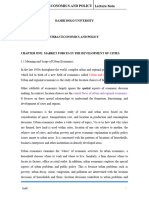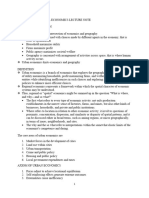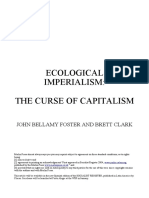Lecture Notes, Lectures 1 - Introduction & Axioms of Urban Eco Lecture Notes, Lectures 1 - Introduction & Axioms of Urban Eco
Uploaded by
minlwintheinLecture Notes, Lectures 1 - Introduction & Axioms of Urban Eco Lecture Notes, Lectures 1 - Introduction & Axioms of Urban Eco
Uploaded by
minlwintheinlOMoARcPSD|2606648
Lecture notes, lectures 1 - introduction & axioms of urban eco
Regional and Urban Economics (Universidad Carlos III de Madrid)
StuDocu is not sponsored or endorsed by any college or university
Downloaded by Min Lwin Thein (minlwinthein@gmail.com)
lOMoARcPSD|2606648
INTRODUCTION & AXIOMS OF URBAN CCONOMICS
1. What is Urban Cconomics?
It is defined as the intersection of geography and economicsn Urban economics
puts economics and geography together, exploring the geographical or location choices
of utility-maximizing households and profit-maximizing firmsn It identifies ineddiciencies
in location choices and examines alternative public policies to promote efficient
choicesn
2. What is a city?
A city is a place with a relatively high population density: a geographical area that
contains a large number of people in a relatively small arean Cities are defined as the
absence of physical space between people and firms given that a frequent contact
between different economic activies is neededn The advantage of cities comes
exclusively from eliminating transportation costs for goods, people and ideasn Now,
almost a half of the world's population lives in cities – in the next 75 years almost the
entire world will don Productivity and cities go togethern
According to census, we can differentiate between different concepts:
• Urban area: geographical area with a minimum population of 2500 people and a
minimum density of 500 peoplen
• Urban population: people living in urban areasn
• Metropolitan area: a core area with a substantial population nucleus, together
with adjacent communities that are integrated, in an economic sense, with the
core arean The minimum population is 50000 peoplen
• Micropolitan area: smaller version of a metropolitan area that counts on between
10000 and 50000 inhabitantsn
• Principal city: the largest municipality in each metropolitan or micropolitan
statistical arean A municipality is defined as an area over which a municipal
corporation exercises political authority and provides local government servicesn
3. Why do cities exist?
Cities exist because human technology has created systems of production and
exchange that seem to defy the natural ordern Three conditions must be satisfies for a
city to develop:
1. Agricultural surplus: people outside cities must produce enough food to feed
themselves and city dwellers so that cities inhabitants don't need anymore the
lands they were surrounded byn
2. Urban production: city dwellers must produce something to exchange for food
grown by rural workersn
3. Transportation system for exchange: there must be an efficient transportation
system to facilitate the exchange of food and urban productsn
4. Axioms of Urban Cconomics
An axiom is a self-evident truth, something that most people readily understand
and accept even if it is not provedn
Axiom 1: Prices adjust to achieve locational equilibrium
A locational equilibrium occurs when no one has an incentive to moven To
eliminate the incentive to move, houses' prices cannot be the same, they adjust to
generate the same utility level in different environments, getting people to live in both
desirable and undesirable locationsn The same happens with wages for workers (those
working in less desirable locations, earn more) and with land rents (land rent in the
Downloaded by Min Lwin Thein (minlwinthein@gmail.com)
lOMoARcPSD|2606648
centre of a city is more expensive than land rent on fringe)n
Axiom 2: Self-reinforcing effects generate extreme outcomes
A self-reinforcing effect is a change in something that leads to additional changes
in the same directionn This is one of the reasons of the creation of clustersn
Axiom 3: Cxternalities cause inefficiency
An externality is the cost or benefit of a transaction experienced by someone
other than the buyer or the seller, that is, someone external to the transactionn An
external cost occurs when a consumer pays a price that is less than the full cost of
producing a product (it does not normally include environmental costs)n An external
benefit occurs when a product purchased by one person generates a benefit for someone
elsen When there are external costs or benefits we do not expect the market equilibrium
to be socially efficientn
Axiom 4: Production is subject to Cconomies of scale
Economies of scale occur when the average cost of production decreases as
output increasesn They occur for two reasons:
– Indivisible inputs: some capital inputs cannot be scaled down for small
operationsn As output increases, the average cost decreases because the cost
of the indivisible input is spread over more outputn
– Factor specialization: in a large operation with plenty of workers, each worker
specializes in a few tasks, leading to higher productivity because of continuityn
Axiom 5: Competition generates zero economic profit
When there are no restrictions on the entry of firms into a market, we expect
firms to enter the market until economic profit is zeron Firms earn just enough to stay in
business, but not enough to attract entrantsn
Downloaded by Min Lwin Thein (minlwinthein@gmail.com)
You might also like
- Lesson 2 - Urbanization and Rural-Urban Migration - SummaryNo ratings yetLesson 2 - Urbanization and Rural-Urban Migration - Summary6 pages
- Chapter 7 Urbanization and Rural-Urban Migration - Theory and Policy67% (3)Chapter 7 Urbanization and Rural-Urban Migration - Theory and Policy22 pages
- Planning Theory: Unit 04 Assignment-05 SOAS21MPLN0007No ratings yetPlanning Theory: Unit 04 Assignment-05 SOAS21MPLN00079 pages
- Urban Economics and Policy Lecture NoteNo ratings yetUrban Economics and Policy Lecture Note99 pages
- Lecture Notes Lectures 2 Why Do Cities Exist PDFNo ratings yetLecture Notes Lectures 2 Why Do Cities Exist PDF3 pages
- Urban Studies Unit 4.docx_20241222_233418_0000No ratings yetUrban Studies Unit 4.docx_20241222_233418_000012 pages
- Urbanization and Rural Urban Migration (2)No ratings yetUrbanization and Rural Urban Migration (2)1 page
- Chapter 1; Introduction to urban economicsNo ratings yetChapter 1; Introduction to urban economics24 pages
- Development Planning and Project Analysis I Ch-4No ratings yetDevelopment Planning and Project Analysis I Ch-446 pages
- Topic 1 - Introduction To Urban and Regional EconomicsNo ratings yetTopic 1 - Introduction To Urban and Regional Economics8 pages
- Urbanization and Rural-Urban Migration: Theory and Policy100% (1)Urbanization and Rural-Urban Migration: Theory and Policy33 pages
- 7299_Topper_21_101_504_547_10315_Introduction_to_Microeconomics_up201706271533_1498557823_2097No ratings yet7299_Topper_21_101_504_547_10315_Introduction_to_Microeconomics_up201706271533_1498557823_20974 pages
- Grade 9 Business Studies Teachers GuideNo ratings yetGrade 9 Business Studies Teachers Guide61 pages
- Lesson 2_urbanization and Rural-urban Migration_group 2No ratings yetLesson 2_urbanization and Rural-urban Migration_group 28 pages
- The 12 Pillars of Competitiveness (World Economic Forum)No ratings yetThe 12 Pillars of Competitiveness (World Economic Forum)8 pages
- Lecture 4- Urbanization and Rural-Urban MigrationNo ratings yetLecture 4- Urbanization and Rural-Urban Migration40 pages
- The 12 Pillars of Competitiveness (World Economic Forum)No ratings yetThe 12 Pillars of Competitiveness (World Economic Forum)9 pages
- Managerial Economics: Yilkal Wassie (Assistant Professor) 2019No ratings yetManagerial Economics: Yilkal Wassie (Assistant Professor) 201935 pages
- Chapter One Urban Economics Definition, Concepts and Scope83% (6)Chapter One Urban Economics Definition, Concepts and Scope3 pages
- Economics Scarce Resources: Labor, Capital, and Entrepreneurship Will Lead To The Production of ApplesNo ratings yetEconomics Scarce Resources: Labor, Capital, and Entrepreneurship Will Lead To The Production of Apples6 pages
- 2.1 - Sample 1 - Power Purchase Agreement (Coal-Fired Plant)100% (1)2.1 - Sample 1 - Power Purchase Agreement (Coal-Fired Plant)120 pages
- Economic Evaluation Applied To Wind Energy ProjectsNo ratings yetEconomic Evaluation Applied To Wind Energy Projects12 pages
- Understanding Power Transmission FinancingNo ratings yetUnderstanding Power Transmission Financing256 pages
- Seminar Assignments Multiple Choice Questions City Size Growth PDFNo ratings yetSeminar Assignments Multiple Choice Questions City Size Growth PDF4 pages
- Network Protection & Automation Guide - NPAG 2011 Alstom100% (1)Network Protection & Automation Guide - NPAG 2011 Alstom508 pages
- Seminar Assignments Multiple Choice Questions Why Do Firms Cluster PDFNo ratings yetSeminar Assignments Multiple Choice Questions Why Do Firms Cluster PDF7 pages
- Seminar Assignments - Multiple Choice Questions - Chapter 9 & 10 Seminar Assignments - Multiple Choice Questions - Chapter 9 & 10No ratings yetSeminar Assignments - Multiple Choice Questions - Chapter 9 & 10 Seminar Assignments - Multiple Choice Questions - Chapter 9 & 103 pages
- Seminar Assignments Multiple Choice Questions Urban Land Rent PDFNo ratings yetSeminar Assignments Multiple Choice Questions Urban Land Rent PDF4 pages
- English Olympiad Study Guide 2018 Web PDFNo ratings yetEnglish Olympiad Study Guide 2018 Web PDF88 pages
- Lecture Notes Lectures 3 Why Do Firms Cluster PDFNo ratings yetLecture Notes Lectures 3 Why Do Firms Cluster PDF4 pages
- ဆရာေအာင္ဟိန္းေက်ာ္ - ဆရာလြတ္အဂၤလိပ္စာေရးနည္း (၂)75% (4)ဆရာေအာင္ဟိန္းေက်ာ္ - ဆရာလြတ္အဂၤလိပ္စာေရးနည္း (၂)195 pages
- ဆရာေအာင္ဟိန္းေက်ာ္ - ဆရာလြတ္အဂၤလိပ္စာေရးနည္း (၂)75% (4)ဆရာေအာင္ဟိန္းေက်ာ္ - ဆရာလြတ္အဂၤလိပ္စာေရးနည္း (၂)195 pages
- DELTA IA-HMI DOP-Series C EN 20160321 PDFNo ratings yetDELTA IA-HMI DOP-Series C EN 20160321 PDF28 pages
- Kertas Sebenar 2014 Bahasa Inggeris 1119-2100% (2)Kertas Sebenar 2014 Bahasa Inggeris 1119-215 pages
- Ship Sanitation Control Exemption Certificate0% (1)Ship Sanitation Control Exemption Certificate3 pages
- PD 1067 - The Water Code of The PhilippinesNo ratings yetPD 1067 - The Water Code of The Philippines64 pages
- Environmental Quality (Refrigerant Management) (Amendment) Regulations 2004 - P.U. (A) 395-2004 PDFNo ratings yetEnvironmental Quality (Refrigerant Management) (Amendment) Regulations 2004 - P.U. (A) 395-2004 PDF2 pages
- R H R C H E C R: Egenerating The Uman Ight TOA Lean and Ealthy Nvironment in The Ommons EnaissanceNo ratings yetR H R C H E C R: Egenerating The Uman Ight TOA Lean and Ealthy Nvironment in The Ommons Enaissance229 pages
- Foster and Clark On Ecological Imperialism PDFNo ratings yetFoster and Clark On Ecological Imperialism PDF17 pages
- Nonanthropocentrism: Prepared By: Israel Joseph R. SoberanoNo ratings yetNonanthropocentrism: Prepared By: Israel Joseph R. Soberano31 pages
- Practice Manual For Small Dams - FeasibiltyNo ratings yetPractice Manual For Small Dams - Feasibilty6 pages










































































































